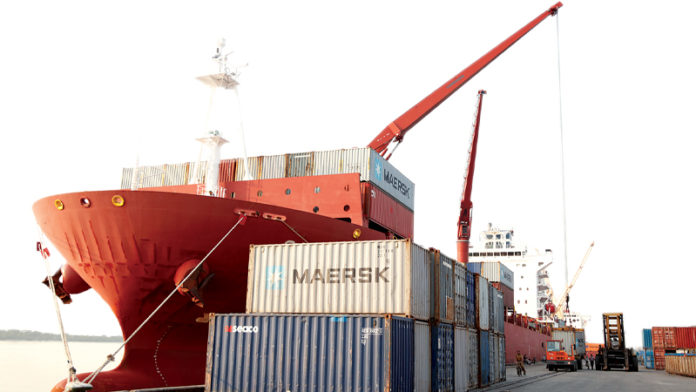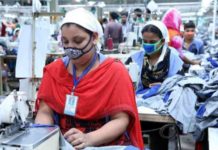Losses, strikes and handling of few ships- these words are now a thing of the past. Most of the news about Mongla port that came to the media a decade ago was full of these negative words. Mongla port suffered losses till the 2007-2008 fiscal year. Compared to that, in the 2008-09 fiscal year, it made a profit of about Tk 3 crore. In the last fiscal year, the profit has crossed Tk 130 crore, which is almost 43 times more than a decade ago. A significant turning point for Mongla port, which was primarily dependent on exports of jute and jute products, was when it started exporting garments in 2019. Development projects such as the Padma bridge, the Rampal thermal power plant and the establishment of the economic zone in the south-western part of the country are increasing the importance of Mongla port. Already, Mongla has made a name for itself within India’s ‘Seven Sisters’ and as the transit port of Nepal and Bhutan. On the 71st anniversary of the establishment and the Golden Jubilee of Independence of Bangladesh, it has to be noted that the journey behind the successful port wasn’t an easy one. Due to the timely development plan of the government and its implementation, Mongla is transforming from a neglected port to an important gateway of import-export trade of the country.
Its journey started based on jute exports
During the partition, jute and jute products were the main export items of East Pakistan. As Chittagong was the only seaport in East Pakistan, the entire port was used for transporting export goods. Its location is in the south-eastern region of the country, but the majority of jute and jute products were produced in the south-western region. As a result, the then government started looking for alternatives to Chittagong port, to save on transportation costs and time. At the same time, when the Korean War broke out, the demand for jute and jute products in the international market increased exponentially. At that time, it became difficult for Chittagong port to transport the import and export goods alone. As a result, the then government, considering the importance of international trade, adopted a plan to establish the second seaport in East Pakistan. The journey of Mongla port started on 1 December 1950. 10 days after the establishment, on 11 December, a British trade ship anchored in the Sundarbans, at a place called Joymonirgol on the Pashur River. This was the first ship that arrived after the establishment of Mongla port. On 7 March 1951, the port was shifted to a place called Chalna, 14 miles upstream from Joymonirgol. The port was operational there till 1954.
Later, a survey was conducted on the Pashur and Shibsa rivers. The survey suggested shifting the port from Chalna to Mongla. The junction of the Mongla river and the Pashur river, 9 to 10 miles downstream from Chalna, was called Mongla. This place also offered greater navigability. Due to having extensive land and being well suited for the construction of a port, on 20 June 1954, the port was shifted to Mongla.
Due to the increasing export trade in jute and jute products, sugar, leather and newsprint, the government adopted a plan to make Mongla port infrastructurally viable. In 1964, it hired a consultancy firm of the United States, Messrs Frederic R. Harris, to conduct a capacity-building survey at the port. After the survey, the firm presented a report stating that it was possible to build a permanent port on the east bank of the Pashur river. In 1965, the government of Pakistan initiated the development of Mongla port based on this report. From 1965 to 1980, in the first phase, necessary land acquisition, water surveying and additional activities were carried out. 2,058 acres of land were acquired.
Mongla port during the War of Liberation
When the War of Liberation started in 1971, almost all the activities of the port were stopped. After 25 March, the Pakistani army attempted to capture Mongla port but was met with strong resistance from the armed Bengali youths. On the 28 and 29 of March, the Pakistani navy started firing shells from the warships. As a result, the weak defence of the Bengalis was crushed and the port became deserted. Shells caused extensive damage to the port. Later, the Pakistani army occupied the port and tried to make it operational. At first, the port was devoid of ships but later due to the massive campaign of West Pakistan, one or two ships kept arriving. A large number of Pakistani soldiers built strong bases in the port area. In mid-August, the heroic Bengali freedom fighters launched a guerrilla attack on Mongla and took control of the port. This was a significant incident of that time.

Earlier, in the first week of June, some Bengali submariners of the Pakistani navy fled from France and joined the War of Liberation. The naval commando unit of heroic freedom fighters was formed. Their training arrangements were made at a secret place on the banks of the Bhagirathi river in the Murshidabad district in India. The code name for this camp was C-2P. Its purpose was to form a naval suicide squad. Their training continued under the watchful eye of the Indian navy. Their operation started after the training was complete when a team of 40 naval personnel went to Mongla. Submariner Ahsanullah was the leader of the team. On 14 August, they launched a commando operation on a ship berthed at the port. As a result, 6 foreign ships were wrecked and sank. The purpose of the operation was to weaken the morale of the Pakistani forces and to make the whole world aware of the volatile situation in Bangladesh. Therefore, the Mongla port became non-functional again. The port remained stagnant until the country gained independence.
Bangabandhu led the resurrection
The port was in a state of destruction after the country became independent. The shipwrecks created obstructions in the port channel. All the necessary tugboats, pilot boats, cranes, and other equipment were almost unusable. During such a situation, efforts were being made to normalise the port as quickly as possible. What was most important for rebuilding the newly independent country was to make the port operational again. At that time, a primary survey was conducted. The sunken ships underneath the port-channel became a hindrance. During the transitional period, the Father of the Nation Bangabandhu Sheikh Mujibur Rahman emerged as the draftsman for the transformation of the port. After his official visit to Moscow, he called on the then Soviet government to cooperate in clearing the port channel. At the request of Bangabandhu, an agreement was signed on 22 March 1972 between Bangladesh and the Soviet Union to remove the wrecked and sunken ships. The port was then made operational by removing the sunken ships and importing the necessary repair equipment. In 1973, a plan was adopted to construct 7 jetties and work began in January 1974. However, in 1977, another amendment was made to build 5 jetties instead of 7.
The construction of the RCC jetty was inaugurated on 18 July 1977. Nine complementary projects were also launched for the implementation of the main project. Sea-going ships started berthing at the 5 newly constructed jetties from 3 February 1983.
A bump in the road
Until the mid-eighties, Mongla was a lucrative port to the southwestern traders. From then on, the condition of the port gradually started deteriorating. Due to the decline of demand for jute and jute products in the world market, the closure of jute mills in the country and the diversification in export products, exports through the port also declined at a significant rate. In the next few years, especially in the ‘90s, the usability of the Mongla port decreased due to negligence and the reduced navigability of the Pashur river channel. At one point, ship arrival at the Mongla port declined to near zero.
Beginning of transformation: From curse to bless
Due to its geographical location, Bangladesh, which is situated on the coast of the Bay of Bengal, is very important to other countries in Asia. The acquisition of vast territorial waters after resolving maritime disputes with India and Myanmar has resulted in increasing Bay of Bengal-centric activities. This is because the seaport-based economy of Bangladesh is getting stronger by utilising the geostrategic advantage of the Bay of Bengal. In addition, the present government took special initiatives at the beginning of 2009 to reduce the singular dependence on Chittagong port and to cope with the growing economic development of the south and south-west. To this end, various steps have been taken to make the Mongla port efficient and operational. To increase the activity of the port, it started importing vehicles in June 2009. In addition, Mongla port has been gradually gaining momentum in port management through the recommendations of the Parliamentary Standing Committee, Port Advisory Committee, the port users and the Ministry of Shipping.
The once cursed port is now a blessing to the country. The entire Khulna region, including Mongla port, is expected to achieve huge economic prosperity within the next decade, contributing more than 2 % to the growth of GDP. Mongla port will be a milestone in fulfilling Bangladesh’s dream of achieving ‘double-digit’ growth.
Padma bridge will increase Mongla port’s importance
According to the ADB survey, about 24,000 vehicles will pass over the Padma bridge every day. This number will increase every year. In 2050, about 67,000 vehicles will pass over the Padma bridge every day. A significant number of vehicles will be transporting goods to and from Mongla. According to the ADB study, the Padma bridge will save an average of two hours for buses and 10 hours for trucks to reach the southern districts. It takes 8 to 10 hours to transport imported goods from Chittagong port to the capital, whereas if the Padma bridge becomes operational, it will take 5 to 6 hours to transport imported goods from Mongla to Dhaka or vice-versa. Construction of Khan Jahan Ali Airport, Khulna-Mongla railway line will open new horizons of connectivity with Mongla.
Mongla port is also important internationally
The importance of Mongla as an international port is increasing day by day. Ships come to this port from Asia, the Middle East, Europe, Australia, Africa, North America and Latin America. Mongla is connected to practically all river ports in Bangladesh, and the coastal shipping agreement has made Mongla more important as an international port by connecting it to the ports of Kolkata and Thailand.
Recently, new possibilities regarding Mongla port have arisen as a result of transit agreements with India and Nepal. Besides, the importance of the Mongla port to Bhutan and China has also increased. As a result of the government’s goodwill to facilitate the use of the port, Mongla port will become one of the significant trade hubs in Southeast Asia.
More advantages at Mongla
Most of the imported goods of Bangladesh come to the country by sea. Besides Chittagong and Mongla, the Payra seaport has also started operations. Chittagong port is at the centre of the country’s import-export trade.
Port users say that Mongla port has more advantages than Chittagong port, especially in regards to car import. Due to the comparatively low cost and the convenience of keeping cars safe, traders are more interested to import cars through Mongla port than Chittagong port. While the Chittagong port is working at full capacity, the capacity of the Mongla port is almost half unused. Besides, traders are inclined to use Mongla port as it takes less time in transportation.
The types of goods that are handled in Mongla port
Mongla port handles three types of goods. Cargos, container goods and cars. About 95% of the port’s total handling is cargo. The remaining share is for container goods and cars. According to the latest master plan of the Strategic Planning and Management Consultants (SPMC), the share of the country’s total imports by sea is 14% and exports only 2%.
On 17 September 2019, for the first time, Mongla port also entered this sector by exporting garments in a 40 feet long containers. Recently, a Polish readymade garments importer has expressed interest in importing garments through Mongla port.
Where Mongla lies ahead
Half of the cars imported through the country’s seaports is now done through Mongla port.
The number of car import depends on the car’s price, the economic situation and the duty payable on the car according to the budget. In the 2014-15 fiscal year, 11,218 cars were released through Mongla port. In the last fiscal year, this number was 14,474. Although the number of cars did not increase at a significant rate in seven fiscal years, Mongla port’s participation in the car import in only 12 years is commendable considering the cost of maintenance and release. The Ministry of Shipping has provided policy support to increase the number.
Record number of ship arrival at Mongla port
The COVID-19 pandemic caused a collapse in port management around the world. Import-export trade has declined. Despite this, the number of ship arrival at Mongla port has not decreased. Mongla port has handled 970 ships in the last (2020-21) fiscal year. In the previous (2019-20) fiscal year this number was 903, although in the 2018-19 fiscal year it was 912. However, according to the statistics of seven years, this number has increased progressively. The number of ship arrival at Mongla port has also increased under the coastal shipping protocol. This number increased to 333 in the last fiscal year compared to 86 ships in the 2014-15 fiscal year.
International standard security
The Mongla Port Authority has been implementing the internationally recognised ISPS code since 2004. From the very beginning, its security department has been working for the security of the port’s trade, installations, officials and employees. Besides, Bangladesh Navy, Bangladesh Coast Guard, and Bangladesh Police are working together with the Mongla Port Authority to prevent any criminal activities within the 130 km channel of the port around the Sundarbans. An officer of the rank of Lieutenant Commander is leading the security department. There is also a fire service unit working under the security department, which is working round the clock to give the port safety from fire hazards.
Services that are available for stakeholders
Equipment: Cargo and container handling services are being provided through 72 pieces of equipment at present under the mechanical and electrical department of the port. Besides, 75 more pieces of equipment are being procured under the capacity-building project. 66 pieces of equipment for the project have already reached the port.
Ships: There are some tugboats to help the cargo and container ships to berth at the port jetty.
One-stop service: For the convenience of the users, the one-stop service is available at the port. This has brought together all the departments directly involved in the operational work in one room.
Short, medium, and long term plans
According to the latest information, the Mongla Port Authority is implementing 9 projects in the short term. Notable among these are procurement of equipment and vessels, preparation of a master plan, enhancement of channel navigability and establishment of VTMIS (Vessel Traffic Management Information System).
Expansion and modernisation of port facilities and Pashur channel conservation dredging are awaiting approval under the medium-term plan.
Besides, the authority has plans to implement 19 development projects in the long run with government funding. These projects have been undertaken for the infrastructural development of the port, purchase of machinery and vessels and installation of modern technology. These projects include Singapore’s investment proposals for the construction of the container, coal, LNG handling jetty at Joymonirgol and a floating jetty at Harbaria.
Beckoning immeasurable possibilities
Compared to Chittagong port, Mongla port does not have much share in import and export trade. The Mongla port, that suffered loss due to negligence, dissatisfaction and lack of foresight, is now in the process of transformation. The establishment, which also made a loss in 2007, has made profits consecutively since the 2008-09 fiscal year. The country’s mega-project Padma bridge and railway link will connect Mongla with different parts of the country including Dhaka. This will reduce the distance and save time. On the other hand, the Mongla port is already connected by an extensive shipping route. Agreements with Nepal, Bhutan, and India on transporting transit goods are also a bonus for Mongla. In the not-too-distant future, the port will emerge as a major South Asian port, serving Bangladesh’s maritime trading demands.




